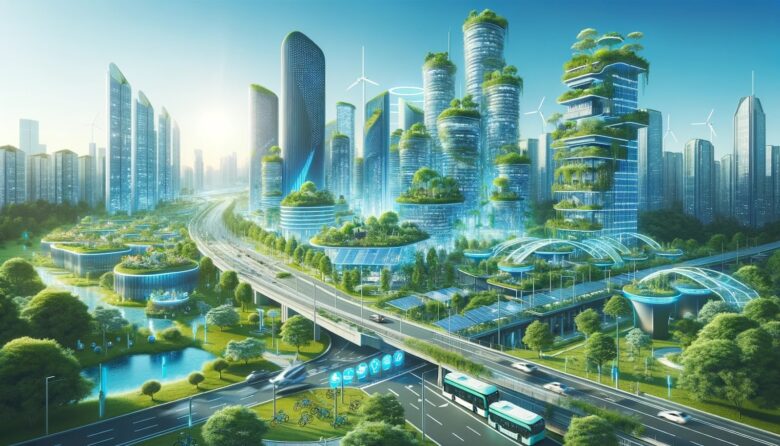The urban centers of the world are evolving quickly as technology meets environmental responsibility. Smart cities are an exciting future for urban life. The latest technologies work in tandem with sustainability objectives to create healthier, more efficient communities. These progressive metropolises are showing that technological innovation and sustainability can coexist harmoniously, providing residents with a better quality of life and cutting down their environmental footprint.
The Rise of Smart Cities
Cities consume more than 70% of the world’s energy and contribute more than 80% of carbon dioxide emissions. This shocking reality has led city planners and the government to reconsider how they function. Smart cities are the solution, integrating Internet of Things (IoT) sensors, artificial intelligence, and data analytics to improve everything from transportation to the consumption of energy. Barcelona, Singapore, and Copenhagen are the leaders, and they have shown how technology can help create livable, sustainable urban areas. These cities make use of real-time information to make educated decisions, which reduce the amount of waste generated and maximize the allocation of resources across the entire range of municipal services.
Key Eco-Innovative Technologies
Smart grids transform the distribution of energy by automatically balancing demand and supply and including renewable energy sources such as wind and solar energy. Lighting systems for streets that are LED-fitted with sensors regulate the brightness according to the speed of traffic and pedestrians, which reduces energy consumption by 50 percent. Innovative waste management methods employ sensors within garbage bins in order to optimize ways to collect garbage, thus decreasing the amount of fuel consumed and emissions generated by garbage trucks. Smart water management uses leak detection sensors as well as automated irrigation systems that help conserve water resources. Electric vehicle charging networks that are powered by renewable energies aid the shift away from the dependence on fossil fuels for transportation.
Benefits of Eco-Innovative Technology
These solutions are measurable economic and environmental advantages for both. Efficiency improvements in energy use can cut the city’s power consumption by 20–30%, which translates to millions of dollars’ worth of savings each year. Monitoring of air quality systems can assist cities in identifying pollution sources and provide targeted solutions, which can lead to healthier communities. The reduction of traffic congestion by smart traffic management can reduce emissions as well as commute times for residents. Water conservation techniques can reduce municipal water consumption by 15–25%, which means we can preserve this resource for the next generation. Employment creation in green technology fields can create economic opportunities while building an eco-friendly workforce.
Challenges and Opportunities
Implementation of eco-friendly technologies faces numerous obstacles. The high upfront cost can be a strain on municipal budgets, which requires innovative financing strategies and public-private partnerships. As cities become increasingly connected and dependent on the digital infrastructure, security concerns escalate. When extensive data collection is necessary to optimize system performance, privacy concerns emerge. But these issues provide opportunities for innovation. Green bonds and sustainability-focused investments provide funding mechanisms for smart city projects. Collaboration between tech businesses, government agencies, and communities leads to innovative solutions that solve both social and technical problems.
Future Trends
Future smart city models will adopt the latest technology. Artificial intelligence can predict and avoid infrastructure failures prior to their happening. Blockchain technology can facilitate an energy trade that is secure, transparent, and safe between communities and buildings. Urban agriculture and vertical farming can reduce the cost of food transportation and greenhouse gas emissions while supplying fresh food to urban residents. Autonomous vehicles will enhance traffic flow and decrease the requirement for parking spaces, opening space for green spaces and use by the community. 5G networks will provide immediate responses to changes in the environment, thereby improving the cities’ ability to withstand climate change.
Building Tomorrow’s Sustainable Cities
The smart cities fueled by eco-friendly technology are our most viable option to live a more sustainable and healthy urban life. While there are some challenges, the benefits outweigh the hurdles. Cities that invest in these technologies right now will benefit from competitive advantages in attracting residents, businesses, and investments. Success stories from early adopters are a blueprint for other cities to emulate. As technology advances and costs drop, eco-friendly intelligent city strategies will be affordable to cities of any size. Urban living’s future is sustainable, bright, and more efficient than ever.
FAQs
1. What is it that makes the city “smart”?
A smart city makes use of the latest technology in connectivity, IoT sensors, and data analytics to enhance city services, decrease consumption of resources, and improve the living standards for residents.
2. What is the cost? Could smart cities help reduce the amount of energy consumed?
Smart cities typically see 20–30% energy savings in their consumption via energy-efficient lighting, smart grids, and streamlined building management systems.
3. What is the biggest issue facing smart city development?
The most significant challenges are the cost-intensive implementation, security risks, privacy concerns, and the need for massive infrastructure improvements.
4. Cities that are at the forefront of eco-innovative technologies?
Copenhagen, Singapore, Barcelona, and Amsterdam are considered to be the leading cities in developing sustainable smart city strategies.
5. How do smart cities improve air quality?
Smart cities make use of the monitoring of air quality, as well as traffic management, in order to reduce emissions and to encourage electric vehicles to improve air quality.




